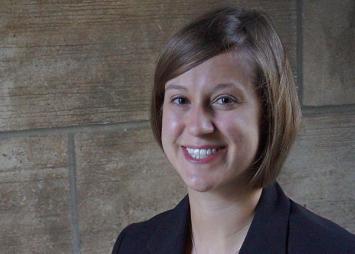Elizabeth Wakefield

Title: Associate Professor
Program: Developmental and Neuroscience
Office: 239 Coffey Hall
Phone: 773-508-3363
E-mail: ewakefield1@luc.edu
Background Information
Post-Doc: University of Chicago
Ph.D.: Indiana University
B.A.: Kalamazoo College
Classes Taught
NEUR 101 Introduction to Neuroscience
PSYC 273 Developmental Psychology
PSYC 377 Psychology of Music
PSYC 545 Developmental Cognitive Neuroscience
Research Interests
In my research program, I focus on how movements we produce and observe every day have the power to help us learn. In particular, I am interested in gestures, movements of the hands that naturally occur with spoken language and can represent information though their form and trajectory. Gesture is commonly used in the classroom, but it is not clear how to optimally exploit it as a teaching tool. Employing behavioral methods and eye tracking, I address this knowledge gap and lay the groundwork for creating evidence-based teaching practices using gesture. My research touches on many learning domains – mathematics, language, spatial and analogical reasoning, and music, and addresses two overarching questions: (1) What mechanisms underlie gesture’s ability to impact learning and promote cognitive change? (2) What individual differences contribute to whether gesture will benefit a learner?
Select Publications
Wakefield, E. M., Novack., M. N., Congdon, E. L., & Howard, L. (2021). Individual differences in gesture interpretation predict children’s propensity to pick a gesturer as a good informant. Journal of Experimental Child Psychology, 205. Article 105069. https://doi.org/10.1016/j.jecp.2020.105069
Guarino, K. F., Wakefield, E. M., Morrison, R. G., & Richland, L. E. (2021). Exploring how visual attention, inhibitory control, and co-speech gesture instruction contribute to children’s analogical reasoning ability. Cognitive Development, 58. Article 101040. https://doi.org/10.1016/j.cogdev.2021.101040
Wakefield, E. M., Congdon, E., L., Novack, M. A., Goldin-Meadow, S., James, K. H. (2019). Learning math by hand: The neural effects of gesture-based instruction in 8-year-old children. Attention, Perception, & Psychophysics, 81, 2343–2353. https://doi.org/10.3758/s13414-019-01755-y
Wakefield, E. M., Foley, A. E., Ping, R., Villarreal, J., Goldin-Meadow, S., & Levine, S. (2019). Breaking down gesture and action in mental rotation: Understanding the components of movement that promote learning. Developmental Psychology, 55(5), 981- 993. https://doi.org/10.1037/dev0000697
Wakefield, E. M., Novack, M. A., Congdon, E. L., Franconeri, S., & Goldin-Meadow, S. (2018). Gesture helps learners learn, but not merely by guiding their visual attention. Developmental Science. Article e12664. https://doi.org/10.1111/desc.12664
Wakefield, E. M., Hall, C., James, K. H., & Goldin-Meadow, S. (2018). Gesture for generalization: Gesture facilitates flexible learning of words for actions on objects. Developmental Science. Article e12656. https://doi.org/10.1111/desc.12656
Wakefield, E. M., Novack, M. A., & Goldin-Meadow, S. (2018). Unpacking the ontogeny of gesture understanding: How movement becomes meaningful across development. Child Development, 89(3), e245-e260. https://doi.org/10.1111/cdev.12817
Novack, M., Wakefield, E. M., & Goldin-Meadow, S. (2016). What makes a movement a gesture? Cognition, 146, 339-348. https://doi.org/10.1016/j.cognition.2015.10.014
Wakefield, E. M., James, T. W., & James, K. H. (2013). Neural correlates of gesture processing across human development. Cognitive Neuropsychology, 30(2), 58-76. https://doi.org/10.1080/02643294.2013.794777

